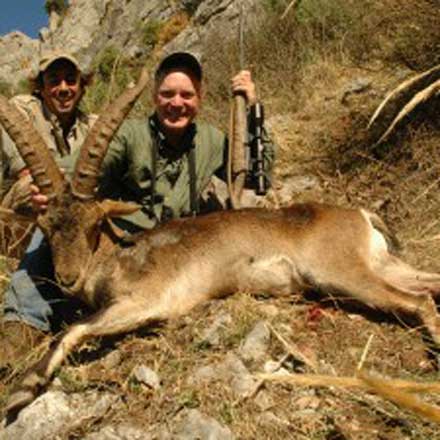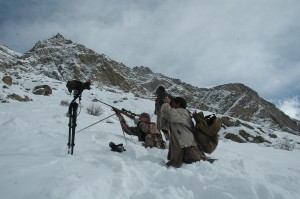
Nearly 90 years ago Theodore Roosevelt’s son, Kermit, journeyed to the Tien Shan Mountains of western China. His book, East of the Sun, West of the Moon, is a legacy of adventure only slightly less rich than the great literary legacy left by his slightly more famous father. From a hunting standpoint, that Roosevelt expedition is fascinating because the primary and most prized quarry was the ibex found in those Asian mountains with its long, curving, heavily ridged horns. The argali sheep they hunted along the way were considered little more than camp meat.
Today, the situation is reversed. Hunters travel to the mountains of the Old World and pay astounding prices to hunt wild sheep, paying little attention to the long-horned races of ibex that inhabit the same mountains. I have never understood exactly how or why this came to pass, but if you can somehow get past the mystique of the wild sheep, there is fantastic ibex hunting in both Europe and Asia. The mountains are the same. The sense of adventure is equal. The effort is sometimes greater because wild goats tend to thrive in country that is too steep and too rugged for sheep. The cost is generally far less.
Mongolia was a country I had long wanted to hunt. We crazy sheep hunters have subdivided Mongolia’s big argali sheep into three races: High Altai, Hangay, and Gobi argali, more or less in that descending order of size. I’d have been happy with any one of the three and should have done such a hunt 30 years ago, when prices were laughable by today’s standards. But I couldn’t afford those laughable prices back then, and as permits became more limited, the costs continued to go up. I finally accepted that I was both unwilling and unable to shell out for a Mongolian sheep hunt. Instead, I did a three-week round-robin Mongolian safari that included three areas: The northern forests for Siberian roebuck and wolf, the Gobi Desert for the smaller Gobi ibex and gazelles, and the Altai Mountains for the big Siberian ibex and all for less than half the cost of the best deal I could make for the least expensive Mongolian argali! Similar situations exist all over Central Asia.
The ibex is a true wild goat, genus Capra, existing discontinuously in numerous races and subspecies from the Iberian Peninsula eastward to China and Mongolia. The taxonomic “splitters” have had a field day with ibex. Now there are more than 14 varieties identified: Six in Europe (four in Spain,...
plus the Alpine ibex and the small Cretan ibex or kri-kri), two in North Africa (the protected walia ibex in Ethiopia, the Nubian ibex spanning both sides of the Red Sea, also occurring in Asia), and perhaps seven more across Southwestern and Central Asia.

There is growing awareness of the value of the ibex as game animals, or perhaps there are more guys like me who can’t afford sheep but love mountain hunting! The Grand Slam/Ovis organization recognizes the “Capra World Slam” for taking 12 varieties of the world’s wild goats, with additional recognition for passing the (difficult!) 20-variety milestone and (almost impossible!) 30-variety milestone. Admittedly, you have to be a little nuts to want to go that far, but it’s good to see the wild goats getting the credit they richly deserve as game animals.
On the other hand, with increased interest, the bargains are shrinking! There remains, however, a significant gap between the cost of most sheep hunting and the cost of most goat hunting. In general this still applies to the ibex, at least partly because they are a widespread clan, and in many situations occupy the same general range as wild sheep. Mongolia is a classic example with the big and impressive Siberian ibex being one of the great (and few remaining) bargains in the hunting world. It’s similar in Pakistan. I went there in February 2008 with the Blanford Urial sheep as my primary objective. The hunt was too easy and, in my view, overpriced, but at least I had sense enough to get a permit for the Sindh ibex found in the same area. This is a small-bodied desert ibex that grows incredible horns. Tthe ibex portion in that area was a better hunt for a more impressive trophy at about half the cost of the sheep.
Then I went to the big mountains of northeastern Pakistan and hunted the Himalayan ibex, a big brute of a goat with lots of color in the coat and fantastically thick horns. This ibex is the most reasonably priced of all of Pakistan’s premier species. In the shadow of some of the world’s tallest peaks, the Himalayan ibex offers one of the world’s great mountain hunts, a wonderful experience.
A number of...
races of ibex are hunted more or less a la carte, meaning they stand alone as premier animals in their areas and not in the shadow of more prestigious animals like sheep. These would include Turkey’s Bezoar goat, and all of the six European ibex. The situations are somewhat different with all of them. Unfortunately, ibex hunting in Turkey has gotten expensive. To some extent, this is my fault. Quite some years ago, when trophy quality was thought to be “so-so,” I hunted ibex in Turkey at a very modest price. My ibex was okay, but on the last day of the hunt my buddy, Joe Bishop, shot a monster, at the time the largest Bezoar goat ever taken in Turkey, second only to a huge billy from Iran. The prices started to go up that day and have kept going up since as more and more really big ibex are taken. The Cretan ibex, or kri-kri, today hunted only in introduced populations on a couple of Greek islands and in Macedonia, have also gone up quite a bit. This is mostly supply and demand; nobody knew about this ibex a few years ago, and it was a very inexpensive hunt. But he word got out, and permits are very limited.

The situation with the Spanish ibex and the Alpine ibex is quite the opposite. There are more permits available every year, so the value of the Alpine ibex has actually dropped, while permits for the four Spanish ibex have remained very stable for many years. As an example, I took my first Spanish ibex, the Gredos variety, in about 1992 when permits were still fairly scarce. I took the fourth, the small Ronda ibex, in 2009. The word got out, and permits are very limited.
The price for each hunt, 17 years apart, was exactly the same. So, in real terms, you could say these ibex are more reasonable now than ever before!
Over the years I’ve taken most of the available races of ibex. I like mountain hunting, and they have been much more affordable than sheep. One I don’t have, and a couple of the biggest mistakes I’ve made, is the big mid-Asian ibex of Central Asia, the same ibex that Kermit Roosevelt wrote about. They occupy the same basic range as the Marco Polo argali, so on two different sheep hunts...
in Tajikistan I had the chance to take an ibex…for something minimal like another $1500. Unfortunately I was stretched as thin as I could stretch, and neither time did I have another $1500! So I’ll have to go back and try for that ibex again one of these days. It will cost quite a bit more—but that ibex remains one of the great bargains in the world of mountain hunting.